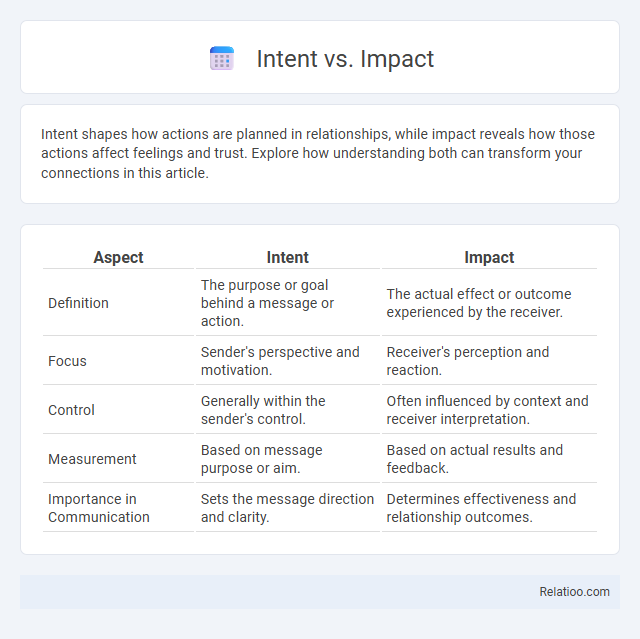Intent shapes how actions are planned in relationships, while impact reveals how those actions affect feelings and trust. Explore how understanding both can transform your connections in this article.
Table of Comparison
| Aspect | Intent | Impact |
|---|---|---|
| Definition | The purpose or goal behind a message or action. | The actual effect or outcome experienced by the receiver. |
| Focus | Sender's perspective and motivation. | Receiver's perception and reaction. |
| Control | Generally within the sender's control. | Often influenced by context and receiver interpretation. |
| Measurement | Based on message purpose or aim. | Based on actual results and feedback. |
| Importance in Communication | Sets the message direction and clarity. | Determines effectiveness and relationship outcomes. |
Understanding Intent vs Impact
Understanding intent vs impact is crucial in effective communication, as intent refers to the purpose behind your message while impact is the actual effect it has on the audience. You may intend to convey kindness or clarity, but the impact can be misinterpreted based on tone, context, or personal experiences. Recognizing this gap helps avoid misunderstandings, encouraging empathy and active listening to align your intended message with how it is received.
Why Intent Doesn’t Equal Impact
Intent doesn't equal impact because your intentions reflect your internal mindset, while impact is based on how others perceive and experience your actions. Misunderstandings arise when the message received differs from the message intended, often influenced by cultural, emotional, or situational factors. Recognizing this gap helps you communicate more effectively and take responsibility for the effect your words or behavior have on others.
Common Scenarios Highlighting Intent vs Impact
In workplace communications, a colleague's well-intentioned feedback may unintentionally cause offense, highlighting the gap between intent and impact. Your careful choice of words can be misinterpreted due to cultural differences or tone, leading to misunderstandings despite positive intent. Recognizing this dynamic improves empathy and clarifies communication to minimize conflicts.
The Role of Communication in Bridging the Gap
Effective communication plays a crucial role in bridging the gap between intent, impact, and misunderstanding by ensuring clarity and empathy in message delivery. Clear articulation of intent minimizes ambiguity, while active listening and feedback help align the receiver's interpretation with the sender's purpose. Communication tools such as nonverbal cues, tone, and context further enhance understanding, reducing the risk of misinterpretation and fostering stronger interpersonal connections.
Psychological Effects of Misaligned Intent and Impact
Misaligned intent and impact can lead to significant psychological effects such as confusion, frustration, and diminished trust in communication. When your intended message is perceived differently, it may cause feelings of invalidation or emotional distress, impacting relationships and mental well-being. Understanding this gap is crucial for fostering empathy and improving interpersonal dynamics.
Strategies for Clarifying Intentions
Clarifying intentions minimizes misunderstandings by openly communicating your purpose and expectations through clear, concise language and active listening techniques. Employing strategies such as paraphrasing, asking open-ended questions, and providing context ensures your message aligns with how others interpret it. Consistently verifying your intent helps build trust and reduces the risk of misinterpretation in your interactions.
Recognizing and Addressing Unintended Impact
Recognizing unintended impact requires careful examination of how actions are perceived beyond original intent, emphasizing the importance of empathy and active listening in communication. Addressing unintended impact involves acknowledging the gap between intent and outcome, validating others' experiences, and implementing corrective measures to realign intentions with actual effects. Misunderstanding often arises when impact contradicts intent, making transparent dialogue essential to foster awareness and prevent repeated negative consequences.
The Importance of Feedback in Resolving Misunderstandings
Feedback plays a crucial role in bridging the gap between intent and impact, ensuring that your message is accurately understood and any misunderstandings are promptly addressed. By actively seeking and providing clear feedback, communicators can identify discrepancies between what was intended and how it was perceived. Effective feedback fosters mutual understanding and helps prevent conflicts arising from misinterpretations.
Building Empathy to Close the Intent-Impact Gap
Understanding the gap between intent, impact, and misunderstanding is crucial for building empathy and effective communication. Recognizing that Your good intentions might not always translate as expected allows you to validate others' feelings and experiences. Embracing empathy helps close the intent-impact gap by fostering clearer dialogue, reducing conflicts, and nurturing stronger relationships.
Fostering a Culture of Accountability and Awareness
Intent, impact, and misunderstanding are critical concepts that shape communication and relationships within any organization. Fostering a culture of accountability and awareness requires recognizing that while your intent might be positive, the impact on others could differ significantly, necessitating open dialogue and empathy. Encouraging team members to acknowledge misunderstandings promptly helps build trust, ensures responsibility is taken for actions, and promotes continuous learning and improvement.

Infographic: Intent vs Impact
 relatioo.com
relatioo.com